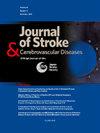Factors associated with adverse outcomes following perioperative stroke after noncardiac surgery
IF 1.8
4区 医学
Q3 NEUROSCIENCES
Journal of Stroke & Cerebrovascular Diseases
Pub Date : 2025-06-06
DOI:10.1016/j.jstrokecerebrovasdis.2025.108346
引用次数: 0
Abstract
Background
Perioperative stroke is associated with high rates of adverse outcomes. Our objective was to identify factors associated with 30-day mortality, adverse discharge, and length of hospital stay following perioperative stroke among noncardiac surgical patients, and to analyze trends in these outcomes from 2005 to 2020.
Study design
A retrospective cohort study of noncardiac perioperative stroke patients was conducted using the American College of Surgeons National Surgical Quality Improvement Program (ACS-NSQIP) database (2005-2020). Data included patient demographics, comorbidities, stroke, and surgical variables. Elastic net penalization identified variables associated with 30-day mortality (primary outcome), adverse discharge (death or non-home facility) and length of hospital stay in multivariable models.
Results
We identified 14,386 patients with perioperative stroke. Strokes occurred a median [interquartile range] of 5 days [2 days to 12 days] after surgery, 24.6 % (N = 3,540) of patients died, and 39.8 % (N = 4,773) were discharged to a non-home facility. Factors significantly associated with 30-day mortality included age, body mass index, postoperative complications, stroke closer to surgery and perioperative blood transfusion (c-statistic = 0.749, 95 % CI 0.739 to 0.758). We did not identify significant changes in mortality and adverse discharge over the study period.
Conclusion
Several factors were significantly associated with increased risk of poor outcome following perioperative stroke, including potentially modifiable factors such as perioperative anemia, and transfusion. Further research is warranted to identify mechanisms and possible interventions to improve outcome in this population.
非心脏手术后围手术期卒中不良后果的相关因素
背景围手术期卒中与高不良结局发生率相关。我们的目的是确定与非心脏手术患者围手术期卒中后30天死亡率、不良出院和住院时间相关的因素,并分析2005年至2020年这些结果的趋势。研究设计:采用美国外科医师学会国家手术质量改进计划(ACS-NSQIP)数据库(2005-2020)对非心源性卒中围手术期患者进行回顾性队列研究。数据包括患者人口统计、合并症、中风和手术变量。在多变量模型中,弹性净惩罚确定了与30天死亡率(主要结局)、不良出院(死亡或非家庭设施)和住院时间相关的变量。结果14386例围手术期卒中患者。卒中发生的中位数[四分位数范围]为术后5天[2天至12天],24.6% (N = 3540)的患者死亡,39.8% (N = 4773)的患者出院至非家庭机构。与30天死亡率显著相关的因素包括年龄、体重指数、术后并发症、手术前卒中和围手术期输血(c-statistic = 0.749, 95% CI 0.739 ~ 0.758)。在研究期间,我们没有发现死亡率和不良排放的显著变化。结论:围手术期卒中预后不良风险增加与几个因素显著相关,包括围手术期贫血和输血等潜在的可改变因素。需要进一步研究以确定改善这一人群预后的机制和可能的干预措施。
本文章由计算机程序翻译,如有差异,请以英文原文为准。
求助全文
约1分钟内获得全文
求助全文
来源期刊

Journal of Stroke & Cerebrovascular Diseases
Medicine-Surgery
CiteScore
5.00
自引率
4.00%
发文量
583
审稿时长
62 days
期刊介绍:
The Journal of Stroke & Cerebrovascular Diseases publishes original papers on basic and clinical science related to the fields of stroke and cerebrovascular diseases. The Journal also features review articles, controversies, methods and technical notes, selected case reports and other original articles of special nature. Its editorial mission is to focus on prevention and repair of cerebrovascular disease. Clinical papers emphasize medical and surgical aspects of stroke, clinical trials and design, epidemiology, stroke care delivery systems and outcomes, imaging sciences and rehabilitation of stroke. The Journal will be of special interest to specialists involved in caring for patients with cerebrovascular disease, including neurologists, neurosurgeons and cardiologists.
 求助内容:
求助内容: 应助结果提醒方式:
应助结果提醒方式:


